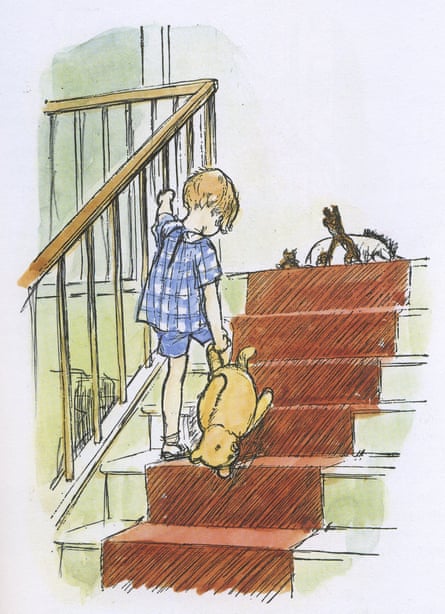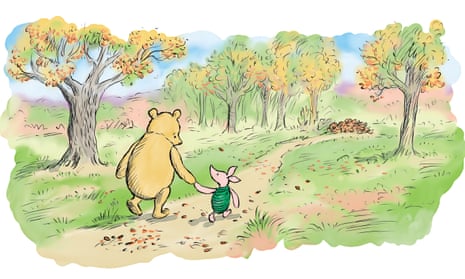Ninety years ago last month, AA Milne’s Winnie-the-Pooh was published; The House at Pooh Corner followed in 1928.
They proved hugely successful, with worldwide sales of the books – including the books of poetry, When We Were Very Young (1924) and Now We Are Six (1927) – of more than 50m. Milne’s biographer, Ann Thwaite, notes that the animals in the Hundred Acre Wood “have become part of the English language”. The commemoration of Pooh’s first book-length appearance is now being celebrated with an official sequel, including a new character.
Yet there are awkward footnotes to this tale of success. Winnie-the-Pooh cruelled AA Milne’s career as a playwright and comic writer and Christopher Milne grew to hate the stories that immortalised him. He once declared it seemed to him “almost that my father has got to where he was by climbing upon my infant shoulders, that he had filched from me my good name and had left me with the empty fame of being his son”.
The estrangement of father and son and difficulties in the Milne marriage make for a rather sad ending, and it will be interesting to see whether these uncomfortable details make it into the biopic that is set to come out next year.
Furthermore, not everyone is a fan of the Bear of Little Brain and the keenest critiques of the books have focused on their sentimentality. Writing under her Constant Reader pseudonym in 1928, Dorothy Parker famously observed of The House at Pooh Corner that the word “hummy” marked “the first place … at which Tonstant Weader fwowed up”. All that honey and condensed milk can be sickly after a while and readers’ tolerance for poetry involving the phrase “tiddely pom” will vary.
The stories are almost parodically genteel and upper middle class; come the revolution it’s doubtful that Pooh will be first against the wall but he won’t be manning the barricades either. Some of the quotes made famous by the books are also perilously close to inspiration-speak and the impression that Pooh is simply a cutesy tug at the heartstrings was no doubt reinforced by the deeply disappointing Disney version, which has all the subtle nuance of a sugared sledgehammer.

However, to read the books and only see treacle is to miss the point. Certainly they are sweet, and if you can read the final story without feeling sad you must be the kind of person unmoved by the most manipulative of Pixar movies; that is, a monster. But Milne is also the sort of narrator who will coolly write that “Owl looked at [Rabbit] and wondered whether to push him off the tree”.
Revisiting the stories, I was surprised to find them as funny as I had at age eight. The Rather Twee Capitalising Of Everything can be grating but it certainly drives the point home: when Pooh, trapped in Rabbit’s front door, requests to be read a “Sustaining Book, such as would help and comfort a Wedged Bear in Great Tightness”, you really feel his pain.
Milne is an acute observer of human behaviour. One story opens: “It was going to be one of Rabbit’s busy days. As soon as he woke up he felt important … It was a Captainish sort of day, when everybody said, ‘Yes, Rabbit’ and ‘No, Rabbit’, and waited until he had told them.”
We have all, I feel, worked with someone like Rabbit.
The stories also gently mock adults’ capacity to say one thing while doing another. Consider the irony in this observation: “‘Pooh,’ said Rabbit kindly, ‘you haven’t any brain.’” Reading the books as a small child, I learned that something might be said kindly but still be unkind; that anything said “carelessly” is probably anything but; that the people most proud of their intellect might just not be that clever. (Owl, who feels it’s “rather beneath him to talk about little cake things with pink sugar icing” is such a deft skewering of pomposity that he’s a cautionary tale for anyone in public life.)
Milne also gives us a character as complex as Eeyore, a bitter and frankly unlikable recluse. The gloomy donkey reminds me perversely of The Simpsons’ Moe Szyslak: such a tragic character that it’s difficult to follow a whole storyline involving him. But Eeyore has appealing moments: think of him contentedly putting a burst balloon in and out of an empty honey jar or frolicking happily when reunited with his tail.
It’s inadvisable to eat honeycomb at every meal but it’s fine in moderation; so it goes with sentimentality. In the Previously Mentioned and Extremely Sad final Pooh story, the narrator concludes that “in that enchanted place on the top of the Forest a little boy and his Bear will always be playing”. Good.
